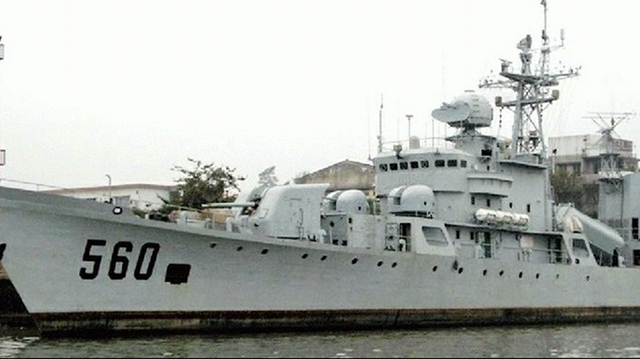SUMMARY
This is AI generated summarization, which may have errors. For context, always refer to the full article.
MANILA, Philippines – It was an accident, Foreign Secretary Albert del Rosario said.
A Department of Foreign Affairs (DFA) official, however, sees the presence of a Chinese warship in the Philippines as a “threat (or) use of force.”
The vessel – a Jianghu-class frigate – was rescued Sunday, July 15, after it was stuck in Half Moon Shoal, an area 60 nautical miles (NM) off the coast of Palawan. China also claims Half Moon Shoal, which is part of the disputed Spratly Islands. (Read: Chinese warship rescued in Half Moon Shoal.)
The shoal is within the Philippines’ exclusive economic zone (EEZ), the area 200-NM from the country’s baselines or “edges” within which it has exclusive rights to explore and exploit marine resources.
Is there anything wrong with the Chinese warship’s presence per se?
In an interview on GMA News TV, DFA Undersecretary for Policy Erlinda Basilio said international law upholds freedom of navigation, or the right of international ships to pass through another country’s waters. She said a crucial factor, however, sets the stranding incident apart.
“Kung warships ‘yung ipinapakita, ipinapadaan-daan mo diyan, hindi na yata tama ‘yun, ‘di ba… Kung warship na, under the Declaration on the Conduct of Parties in the South China Sea, bawal nga ‘yun,” Basilio said.
(If China is already exhibiting warships, I don’t think that’s proper, right? If it’s already a warship, under the Declaration on the Conduct of Parties in the South China Sea, that’s prohibited.)

Del Rosario, however, said the Philippines is unlikely to file a diplomatic protest over the stranded vessel. “We don’t believe that there were ill intentions that accompanied the presence of that ship in our EEZ,” he said. (Read: PH on stranded Chinese ship: No protest.)
OK to pass but…
The DFA bases its statements on the United Nations Convention on the Law of the Sea (Unclos), the prime UN document on maritime affairs.
The Unclos allows foreign ships to pass through a country’s EEZ as long as they don’t pose an economic or security threat. It even allows “innocent passage” through another country’s territorial waters, or the area 12-NM from the country’s baselines.
Under Unclos, this means the passage “shall be continuous and expeditious,” stopping and anchoring only in the case of accidents, among other things. The passage should also not be “prejudicial to the peace, good order, or security of the coastal state,” as when the foreign ship engages in activities like the following:
-
“any threat or use of force against the sovereignty, territorial integrity or political independence of the coastal State, or in any other manner in violation of the principles of international law embodied in the Charter of the United Nations;
-
“any exercise or practice with weapons of any kind;
-
“any act of propaganda aimed at affecting the defence or security of the coastal State;
-
“any fishing activities; and
-
“the carrying out of research or survey activities”
Like Unclos, the Declaration on the Conduct of Parties in the South China Sea upholds freedom of navigation in and overflight above the South China Sea. The code, however, prohibits the use of “threat or use of force” in resolving territorial and jurisdictional disputes.
For a number of netizens, the warship’s presence was a threat that the Philippines needs to protest. (See Storify link below.)
Warships’ presence
It was the first time a Chinese warship prominently figured in a South China Sea incident after the Scarborough Shoal dispute broke out in April.
Reports on Chinese warships in the disputed sea, however, have surfaced several times.
In a Thought Leaders piece for Rappler, maritime analyst Alec Almazan noted an amphibious landing task force of China’s most powerful warships that was reportedly deployed to the disputed waters. (Read: Is China moving to attack the Philippines?)
Taiwan’s Ministry of Defense said the task force consists of the the Chinese Navy’s largest active warship, missile destroyers, and missile frigates, according to Almazan.
Separately, Chinese marine surveillance ships have been conducting “closer observations” at the Spratly Islands. This is part of their mission to patrol the South China Sea, Chinese state media reported in June.
On Sunday, a 30-vessel Chinese fleet also arrived at the Spratlys to fish. The DFA said it is checking if the vessels are within the Philippines’ 200-NM EEZ – in which case the country could file a protest against China over the fishing activities. (Read: 30 Chinese vessels arrive at Spratlys.)
The Unclos bans foreign ships’ economic activities within another country’s EEZ. This is why the Philippines apprehended Chinese fishermen in Scarborough Shoal last April, sparking what is now a 4-month standoff. – Rappler.com
Add a comment
How does this make you feel?
There are no comments yet. Add your comment to start the conversation.